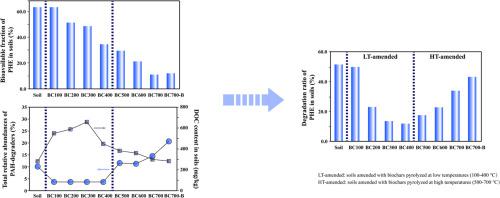Journal of Hazardous Materials ( IF 12.2 ) Pub Date : 2020-11-19 , DOI: 10.1016/j.jhazmat.2020.124584 Zheng Ding , Fan Zhang , Haofei Gong , Ning Sun , Jianjun Huang , Jie Chi

|
This study investigated the impact of wheat straw biochars pyrolyzed at temperatures of 100-700 ℃ (BC100-BC700) on biodegradation of phenanthrene in soils. During a 42-day experiment, biochar amendment reduced the biodegradation ratio of phenanthrene in soils by no change-77.0%. The biodegradation ratio decreased with the increase of pyrolysis temperature from 100 to 400 ℃ and then increased with the increase of pyrolysis temperature from 400 to 700 ℃, exhibiting a U-shape. Meanwhile, desorbing fraction of phenanthrene extracted by n-butanol declined with increasing pyrolysis temperature. Biochar-derived dissolved organic carbon (DOC) obviously influenced the soil DOC contents which were negatively correlated with the total relative abundances of dominant polycyclic aromatic hydrocarbon (PAH)-degraders. These results indicated that in soils amended with biochars pyrolyzed at low temperatures (i.e. 100-400 ℃), both the reduced bioavailability of phenanthrene and the reduced PAH-degrader abundance resulted in decreasing phenanthrene degradation with pyrolysis temperature. In soils amended with biochars pyrolyzed at high temperatures (i.e. 500-700 ℃; HT-biochars), two possible reasons contribute to increasing phenanthrene degradation with pyrolysis temperature: (1) high sorbed-phenanthrene concentration due to large specific surface area and high aromaticity of the biochars, and (2) the increased dominant PAH-degrader abundance for the removal of sorbed-phenanthrene due to the impact of HT-biochars on soil properties (mainly on DOC content).
中文翻译:

在低温和高温下热解的生物炭对菲降解对土壤生物利用度和微生物群落结构变化的响应
本研究研究了在100-700℃(BC100-BC700)温度下热解的小麦秸秆生物炭对土壤中菲生物降解的影响。在为期42天的实验中,生物炭改良剂将土壤中菲的生物降解率降低了77.0%,未发生变化。生物降解率随热解温度从100℃升高到400℃而降低,然后随热解温度从400℃升高到700℃而增加,呈U形。同时,n萃取的菲的解吸分数丁醇随着热解温度的升高而下降。生物炭来源的溶解有机碳(DOC)明显影响土壤DOC含量,与主要多环芳烃(PAH)降解剂的总相对丰度呈负相关。这些结果表明,在低温(即100-400℃)下热解有生物炭的土壤中,菲的生物利用度降低和PAH降解物丰度降低都导致菲在热解温度下的降解降低。在高温下(即500-700℃;高温生物炭)用生物炭改性的土壤中,两个可能的原因导致热分解温度下菲的降解增加:(1)高比表面积和高芳香度导致高吸附菲浓度生物炭











































 京公网安备 11010802027423号
京公网安备 11010802027423号